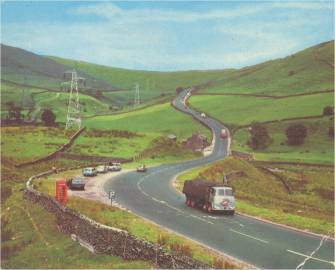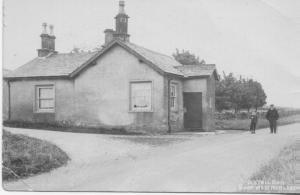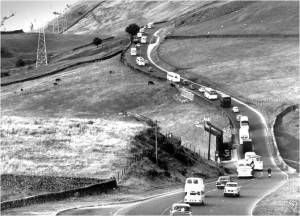The importance of the road through Shap.
 Shap owes much of its development to the fact that it lies on a main route north and south both by road and rail.
Shap owes much of its development to the fact that it lies on a main route north and south both by road and rail.
An ancient road follows a route that criss-crosses the present day road between Kendal and Shap over Shap Fell and through the village; The earliest record of this appears on the 14th century Gough or Bodleian map where the route is clearly shown. An old milestone still survives near the summit of the fell simply inscribed with the numbers 6 and 10 being the mileage from Shap and Kendal. This road was the route used by Bonnie Prince Charlie and his Jacobite supporters in 1745. The route was a very difficult one and when the Jacobite were in retreat back north in December 1745 during horrendous weather, they got bogged down and abandoned much of their arsenal near Forest Hall, and offered men sixpence to carry a cannonball in their baggage. The Prince stayed in Shap and there is an interesting record of that.
Being on an importance coaching route, Shap had several old coaching inns, the Greyhound Hotel, Kings Arms Hotel, Queens Head Hotel, Kings Head Hotel and the New Inn; all had ranges of stabling and other buildings to the rear. Today two still operate as hostelries.
The Heron Syke Turnpike constructed a new road in 1823, this traversed the county of Westmorland from Burton in Kendal to Eamont Bridge and featured iron mile posts dated 1825 giving the mileages to the nearest townships, a few of these still survive. The most accessible is the one near the telephone box at South View (Fell House). In 1824, the engineer appointed as surveyor of roads from Penrith to Kendal was John Louden Macadam, a name synonymous with the tar and gravel mixture used on roads to this day; he lived at Cockell House in Penrith at the time. This road had five toll-bar houses; the one at Shap was situated at the junction with the Orton Road (now the slip road for the M6 motorway) and was demolished in the late 1950s. It is recorded that in 1825 Shap toll bar collected £188. 6s. 0d; and the total collected from all five was £1,140. 2s. 6d. for forty miles of road, half of which was through unproductive wilderness; the income increased to £1,286 in 1926, but by 1872 it had fallen to £800, not doubt due to the fact that the railway which had opened in 1846 had become established. The Heron Syke Trust was abolished in 1882.
this traversed the county of Westmorland from Burton in Kendal to Eamont Bridge and featured iron mile posts dated 1825 giving the mileages to the nearest townships, a few of these still survive. The most accessible is the one near the telephone box at South View (Fell House). In 1824, the engineer appointed as surveyor of roads from Penrith to Kendal was John Louden Macadam, a name synonymous with the tar and gravel mixture used on roads to this day; he lived at Cockell House in Penrith at the time. This road had five toll-bar houses; the one at Shap was situated at the junction with the Orton Road (now the slip road for the M6 motorway) and was demolished in the late 1950s. It is recorded that in 1825 Shap toll bar collected £188. 6s. 0d; and the total collected from all five was £1,140. 2s. 6d. for forty miles of road, half of which was through unproductive wilderness; the income increased to £1,286 in 1926, but by 1872 it had fallen to £800, not doubt due to the fact that the railway which had opened in 1846 had become established. The Heron Syke Trust was abolished in 1882.
The turnpike road was adapted and widened to create the modern day A6. As motorised transport became commonplace, the village became a thriving and bustling place with heavy traffic passing through both s day and night. The arduous route over Shap Fell meant that in winter, the fell would become blocked with jack-knifed vehicles, and a tailback of vehicles would build up right through the village and out of the northern end. On such occasions the drivers would take refuge in the Memorial Hall with emergency food prepared by the local WVS.
 In summer, the annual exodus from the Scottish cities made it virtually impossible to cross the road and this often coincided with the annual Rose Fete procession; the good natured travellers happily helping to the fill the collection buckets.
In summer, the annual exodus from the Scottish cities made it virtually impossible to cross the road and this often coincided with the annual Rose Fete procession; the good natured travellers happily helping to the fill the collection buckets.
Many will remember the enormous Pickford and Scammell units slowly hauling massive boiler parts up into Scotland; and the valiant men muffled up to the eyeballs sitting in all the elements while driving the chassis for lorries and buses into Scotland for coach building.
On the top of the fell there was a café constructed from two old buses, back to back, at one time this was known as Redwings. This was at an ideal place because driver usually pulled off the road following the grind up the fell to allow their engines to cool off. Latterly the cafe was run by Dorothy Houguez, before a brick replacement was build opposite the original site. This finally closed following the opening of the motorway.
In 1970, the extension to the M6 motorway opened, after three years of construction and at the cost of in the region of £60,000,000, for a distance of 36 miles. Overnight the village became quiet, all the heavy haulage transferring to the new motorway. Unfortunately this meant that some businesses closed down after a short time. Today the traffic has increased again to a steady flow.